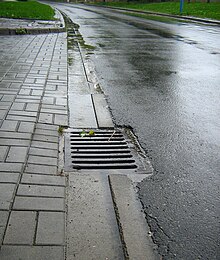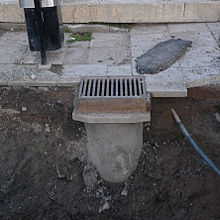

A storm drain, storm sewer (United Kingdom, U.S. and Canada), highway drain,[1] surface water drain/sewer (United Kingdom), or stormwater drain (Australia and New Zealand) is infrastructure designed to drain excess rain and ground water from impervious surfaces such as paved streets, car parks, parking lots, footpaths, sidewalks, and roofs. Storm drains vary in design from small residential dry wells to large municipal systems.
Drains receive water from street gutters on most motorways, freeways and other busy roads, as well as towns in areas with heavy rainfall that leads to flooding, and coastal towns with regular storms. Even rain gutters from houses and buildings can connect to the storm drain. Since many storm drainage systems are gravity sewers that drain untreated storm water into rivers or streams, any hazardous substances poured into the drains will contaminate the destination bodies of water.
Storm drains sometimes cannot manage the quantity of rain that falls in heavy rains or storms. Inundated drains can cause basement and street flooding. Many areas require detention tanks inside a property that temporarily hold runoff in heavy rains and restrict outlet flow to the public sewer. This reduces the risk of overwhelming the public sewer. Some storm drains mix stormwater (rainwater) with sewage, either intentionally in the case of combined sewers, or unintentionally.
- ^ "Highway drain". staffordshire County Council. Retrieved 5 September 2024.